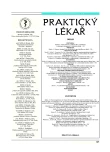-
Medical journals
- Career
Assessment of the opinions of general practitioners in the Czech Republic on the therapeutic strategy in hypertension. Results of the third stage of the DRIVE survey
Authors: J. Widimský 1; M. Sachová 2; V. Lánská 3
Authors‘ workplace: Klinika kardiologie IKEM, Praha 1; Servier s. r. o., Praha 2; Úsek náměstka pro odbornou činnost, IKEM, Praha 3
Published in: Prakt. Lék. 2005; 85(6): 354-357
Category: General Medicine
Overview
The objective of this paper was the identification of opinions among general practitioners (GPs) on the treatment of hypertension. The DRIVE survey has been conducted in the offices of 119 GPs over the period of November 2003 through April 2004. In ten questions the GPs were asked about the diagnostics, onset of treatment, and the therapeutic strategy in patients suffering from hypertension, on the one hand in a group of „young hypertonics” 40–60 years old, and in a group of „elder hypertonics”, i.e. of 70 years or more, on the other.
The results have shown that only 40.5% of physicians initiate treatment of systolic pressure increased to 140–149 mm Hg. In elder patients it is only 17.5%. A whole 38.8% of physicians begin treatment until the systolic pressure level reaches 150–159 mm Hg, and 15.5% begin treatment at the level of systolic blood pressure 160 mm Hg and more.
The situation in elder hypertonic patients is worse to a statistically significant degree (p<0.001); even more than one-third of physicians begin treatment at systolic blood pressure level of 160 mm Hg and more.
In patients with diabetes mellitus, physicians try to be more agressive in treating hypertension. In all, 40.5% physicians begin therapy at a systolic pressure of 130–139 mm Hg as against only 5.3% in hypertonics without diabetes. Only 9.5% physicians begin therapy at the systolic pressure level of 150–159 mm Hg (as against 38.8% in hypertonics without diabetes), and only 2.6% begin treatment of hypertension at the systolic pressure level of ≥ 160 mm Hg (as against 15.5% in hypertonics without diabetes). Nevertheless, even in diabetic patients we have found a significantly lower aggressiveness in the therapy of systolic pressure in patients >70 years old as against younger hypertonics (p<0.001).
From data on the most frequently applied anti-hypertensive drugs there follows a still persevering fear of beta-blockers in the elderly. Their cardioprotective effect, namely in simultaneously present IHD is not lower in old age, but in view of the higher absolute risk, to the contrary it is higher.
Comparison of treatment of hypertension in two case reports from a questionnaire survey in the USA of the same type shows that our GPs are more aggressive in the treatment of systolic hypertension.
From the questionnaires it follows clearly that moderate systolic hypertension in the elderly appears to be the worst treated.Key words:
Opinions of general practitioners – treatment of hypertension – hypertension in diabetes mellitus.
Labels
General practitioner for children and adolescents General practitioner for adults
Article was published inGeneral Practitioner

2005 Issue 6-
All articles in this issue
- Clinical significance of vitamin K for quality of bone and for calcified tissues
- A new tool in the prevention of thromboembolic complications in patients suffering atrial fibrillation - catheter-assisted occlusion of the left atrial auricle by the PLAATO system: Preliminary experience in the Czech Republic
- Defecography in the diagnostics of anorectal dysfunctions
- Cerebral electro- and magnetotherapy in out-patient practice
- Atypical course of type A thoracic aortal dissection in a pregnant woman
- Co-incidence of ischemic disease of peripheral blood vessels and ischemic heart disease
- Complications in the treatment of diabetic foot syndrome using total contact cast, with a focus on osteomyelitis
- Short-term intervention in pathological gambling
- Assessment of the opinions of general practitioners in the Czech Republic on the therapeutic strategy in hypertension. Results of the third stage of the DRIVE survey
- Options of nutrition intervention in primary care
- The principle of dual effect and conscience
- General Practitioner
- Journal archive
- Current issue
- Online only
- About the journal
Most read in this issue- The principle of dual effect and conscience
- Defecography in the diagnostics of anorectal dysfunctions
- Clinical significance of vitamin K for quality of bone and for calcified tissues
- Atypical course of type A thoracic aortal dissection in a pregnant woman
Login#ADS_BOTTOM_SCRIPTS#Forgotten passwordEnter the email address that you registered with. We will send you instructions on how to set a new password.
- Career

